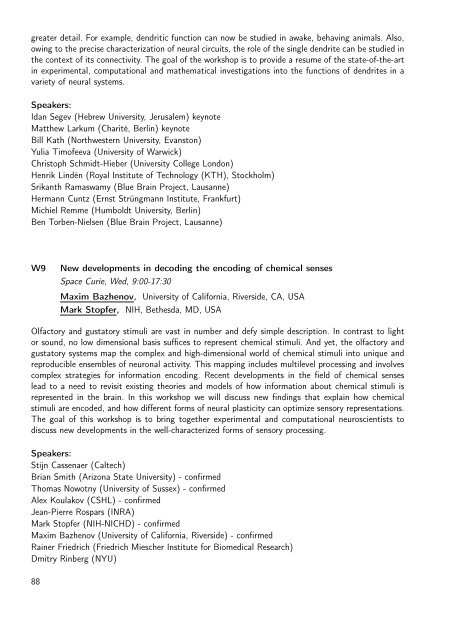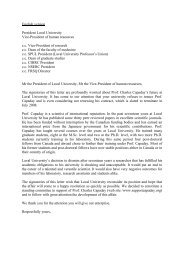Untitled - Laboratory of Neurophysics and Physiology
Untitled - Laboratory of Neurophysics and Physiology
Untitled - Laboratory of Neurophysics and Physiology
Create successful ePaper yourself
Turn your PDF publications into a flip-book with our unique Google optimized e-Paper software.
greater detail. For example, dendritic function can now be studied in awake, behaving animals. Also,<br />
owing to the precise characterization <strong>of</strong> neural circuits, the role <strong>of</strong> the single dendrite can be studied in<br />
the context <strong>of</strong> its connectivity. The goal <strong>of</strong> the workshop is to provide a resume <strong>of</strong> the state-<strong>of</strong>-the-art<br />
in experimental, computational <strong>and</strong> mathematical investigations into the functions <strong>of</strong> dendrites in a<br />
variety <strong>of</strong> neural systems.<br />
Speakers:<br />
Idan Segev (Hebrew University, Jerusalem) keynote<br />
Matthew Larkum (Charité, Berlin) keynote<br />
Bill Kath (Northwestern University, Evanston)<br />
Yulia Tim<strong>of</strong>eeva (University <strong>of</strong> Warwick)<br />
Christoph Schmidt-Hieber (University College London)<br />
Henrik Lindén (Royal Institute <strong>of</strong> Technology (KTH), Stockholm)<br />
Srikanth Ramaswamy (Blue Brain Project, Lausanne)<br />
Hermann Cuntz (Ernst Strüngmann Institute, Frankfurt)<br />
Michiel Remme (Humboldt University, Berlin)<br />
Ben Torben-Nielsen (Blue Brain Project, Lausanne)<br />
W9<br />
New developments in decoding the encoding <strong>of</strong> chemical senses<br />
Space Curie, Wed, 9:00-17:30<br />
Maxim Bazhenov, University <strong>of</strong> California, Riverside, CA, USA<br />
Mark Stopfer, NIH, Bethesda, MD, USA<br />
Olfactory <strong>and</strong> gustatory stimuli are vast in number <strong>and</strong> defy simple description. In contrast to light<br />
or sound, no low dimensional basis suffices to represent chemical stimuli. And yet, the olfactory <strong>and</strong><br />
gustatory systems map the complex <strong>and</strong> high-dimensional world <strong>of</strong> chemical stimuli into unique <strong>and</strong><br />
reproducible ensembles <strong>of</strong> neuronal activity. This mapping includes multilevel processing <strong>and</strong> involves<br />
complex strategies for information encoding. Recent developments in the field <strong>of</strong> chemical senses<br />
lead to a need to revisit existing theories <strong>and</strong> models <strong>of</strong> how information about chemical stimuli is<br />
represented in the brain. In this workshop we will discuss new findings that explain how chemical<br />
stimuli are encoded, <strong>and</strong> how different forms <strong>of</strong> neural plasticity can optimize sensory representations.<br />
The goal <strong>of</strong> this workshop is to bring together experimental <strong>and</strong> computational neuroscientists to<br />
discuss new developments in the well-characterized forms <strong>of</strong> sensory processing.<br />
Speakers:<br />
Stijn Cassenaer (Caltech)<br />
Brian Smith (Arizona State University) - confirmed<br />
Thomas Nowotny (University <strong>of</strong> Sussex) - confirmed<br />
Alex Koulakov (CSHL) - confirmed<br />
Jean-Pierre Rospars (INRA)<br />
Mark Stopfer (NIH-NICHD) - confirmed<br />
Maxim Bazhenov (University <strong>of</strong> California, Riverside) - confirmed<br />
Rainer Friedrich (Friedrich Miescher Institute for Biomedical Research)<br />
Dmitry Rinberg (NYU)<br />
88



